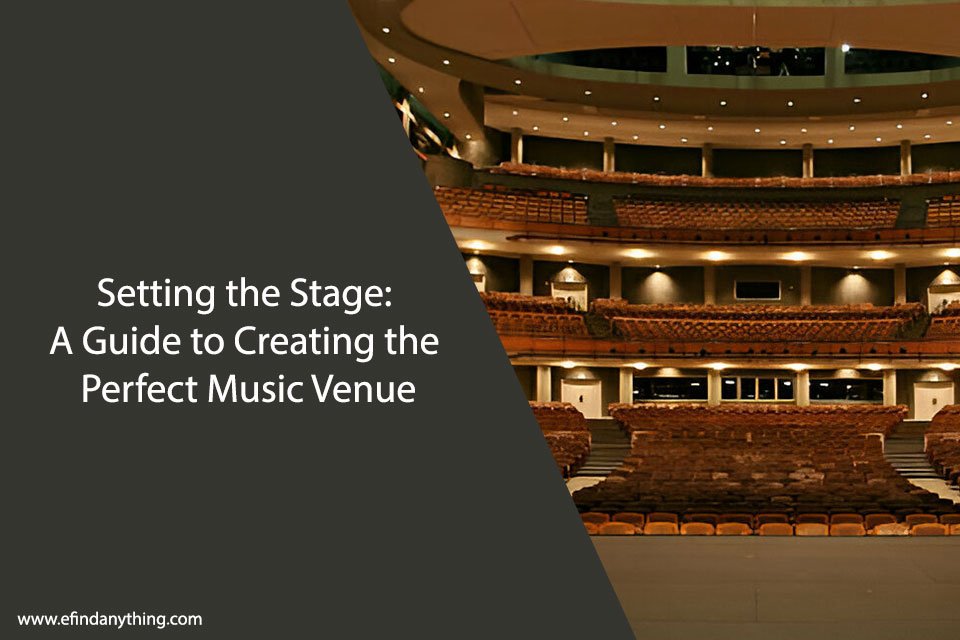Creating the perfect music venue is more than just finding the right location and slapping up a stage. It’s about crafting an experience that resonates with both the artists and the audience, offering an environment where every show feels unforgettable. Whether you’re a live music enthusiast, an event planner, or a business-minded entrepreneur, setting up a successful music venue requires careful planning, attention to detail, and a love for music. This guide will take you through the essential steps to create a space that hits all the right notes.

Table of Contents
1. Choose the Right Location
The first and most important decision when building a music venue is the location. Think about the type of audience you want to attract and the genre of music you’ll host. A local music scene might thrive in a neighborhood that has a high foot traffic of young professionals and college students, while more niche music genres might require a venue that’s situated in a quieter area with less competition.
Here are a few things to consider:
Accessibility
Ensure the venue is easily reachable by public transportation and has adequate parking spaces. The easier it is for people to get to your venue, the better.
Neighborhood Vibe
Does the area fit the mood of the music you want to host? A jazz club might do well in a trendy part of town, while a punk rock venue could be more at home in a grittier, alternative setting.
Competition
Are there other music venues nearby? Too much competition can make it harder to establish your spot, while the absence of other venues might mean you’re filling a gap in the local market.
2. Design the Venue for Sound and Atmosphere
Once you’ve settled on a location, the next big task is the design and layout of the venue. A successful music venue has to offer great acoustics, comfort, and visual appeal. Let’s break it down.
Acoustics
Sound quality is crucial. Collaborate with acousticians and noise control consultants to design the venue so that every note and beat is crisp and clear, regardless of where the audience is seated. The room’s size and shape, the materials chosen for the walls, floors, and ceilings, as well as the sound equipment, all contribute significantly to the overall acoustics of the space.
Stage and Lighting
A good stage should provide visibility and intimacy. The stage should be large enough to accommodate performers but not so far from the audience that the show feels distant. Adjustable lighting can set the right mood, ensuring the spotlight stays where it belongs.
Seating and Layout
Decide on whether your venue will be standing-room only or if it will have seating arrangements. For smaller venues, a more intimate setup with standing and seating areas works well. For larger venues, consider tiered seating for optimal sightlines.
Decor
The vibe of your venue is incredibly important for attracting the right crowd. Whether it’s sleek and modern, industrial and raw, or retro and nostalgic, make sure the decor matches the type of music you’re showcasing.
3. Provide the Best Sound System and Tech Equipment
When it comes to a music venue, high-quality sound equipment is non-negotiable. You’ll need:
- Speakers that can handle everything from acoustic guitar solos to full-band performances with heavy bass.
- Mixing Consoles for sound engineers to control levels and effects during live performances.
- Microphones, amplifiers, and monitors for clear and consistent audio during every show.
- Lighting and special effects equipment to enhance the performance, making it visually exciting.
Investing in top-notch equipment not only improves the audience’s experience but also attracts musicians who want to perform in a space with professional-grade sound.
4. Offer the Right Amenities for Both Artists and Audiences
A great music venue doesn’t just cater to the audience; it also takes care of the performers. Offering artists the right amenities can help draw in more talent and create an environment where they want to return.
Backstage area
This is crucial for artists to prepare and relax before the show. Provide dressing rooms, restrooms, and storage for instruments and equipment.
Bar and Concessions
For the audience, ensure you offer a variety of food and drink options. Whether it’s a full menu or simple snacks and beverages, having a bar or food stand can boost your profits and create a relaxed atmosphere.
Bathrooms and comfort
High-traffic areas need functional and clean bathrooms. Make sure there are enough facilities for the crowd, especially during peak times.
5. Promote Your Venue and Build a Loyal Following
Once your venue is set up and ready to go, the next step is to get the word out. Building a loyal fanbase is essential for long-term success. Here are some ways to promote your venue:
Social media presence
Create active profiles on Instagram, Facebook, Twitter, and TikTok to engage with potential customers and keep them updated on upcoming events.
Collaborate with local musicians and influencers
Partner with musicians, local promoters, and influencers who can help spread the word about your venue.
Create a memorable experience
Word of mouth is powerful. Providing top-tier service, great acoustics, and exciting events will get people talking. Consider offering themed nights or special events to keep things fresh and attract repeat customers.
6. Focus on Safety and Security
Safety is another critical aspect when creating a music venue. From crowd control to health and safety regulations, it’s essential to ensure that both performers and patrons are safe throughout the experience. This includes:
- Hiring professional security staff to manage crowds and prevent any potential issues.
- Complying with fire codes and emergency protocols to ensure the venue can safely evacuate people in case of an emergency.
- Ensuring your venue follows all health regulations, including cleanliness standards and alcohol licensing.
In Conclusion
Creating the perfect music venue is an exciting and rewarding venture. With the right location, a focus on acoustics and atmosphere, state-of-the-art equipment, and great service, you can provide an experience that musicians and music lovers will cherish. By building a space that blends creativity, technical expertise, and a welcoming environment, you’ll set the stage for success and ensure your venue becomes a beloved hub for live music in your community.




